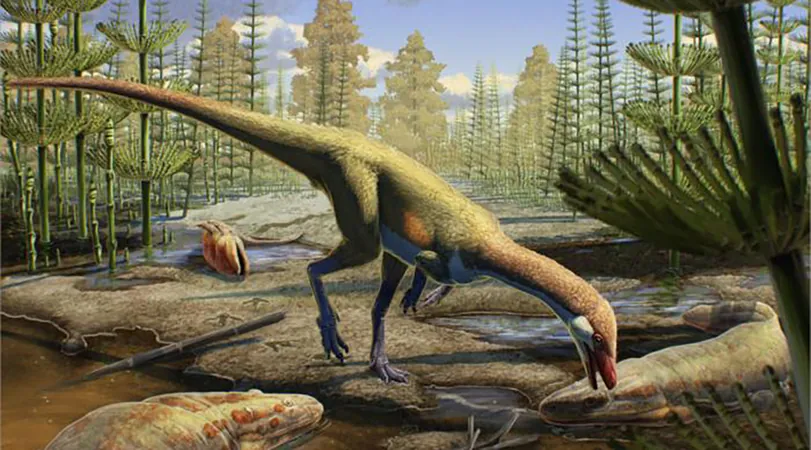
Breakthrough Discovery Challenges Our Understanding of Dinosaur Origins: Meet the Ancient Ahvaytum bahndooiveche!
2025-01-15
Author: John Tan
Breakthrough Discovery Challenges Our Understanding of Dinosaur Origins: Meet the Ancient Ahvaytum bahndooiveche!
A thrilling new discovery in paleontology has rocked the scientific world: a previously unknown dinosaur species suggests that these magnificent creatures roamed the Northern Hemisphere far earlier than previously believed. This revelation opens up a whole new chapter in our understanding of dinosaur evolution and habitation.
Introducing Ahvaytum bahndooiveche
Introducing Ahvaytum bahndooiveche, which translates to "long ago dinosaur" in Shoshone. This remarkable species lived in what is now North America over 230 million years ago, during the Late Triassic period. The fossils were unearthed in Wyoming back in 2013 by a dedicated team from the University of Wisconsin–Madison, but their significance has only just been fully recognized through recent analysis.
Challenging Previous Assumptions
Before this groundbreaking discovery, scientists operated under the assumption that dinosaurs first emerged in the southern landmass of Gondwana before eventually migrating to the Northern Hemisphere. However, the existence of Ahvaytum bahndooiveche proves otherwise—illustrating that the northern expanses of Pangaea, then known as Laurasia, were home to dinosaurs much earlier than anticipated.
Significance of the Discovery
“With these fossils, we have the oldest equatorial dinosaur in the world—it’s also North America’s oldest dinosaur,” exclaimed Dave Lovelace, one of the lead researchers, highlighting the profound impact of this finding. This exciting revelation, published in the Zoological Journal of the Linnean Society, redefines our understanding of the timeline of dinosaur evolution.
Physical Characteristics and Diet
What sets Ahvaytum bahndooiveche apart? Although it likely resembled a chicken in size—standing about one foot tall and stretching approximately three feet in length—its lineage showcases remarkable evolutionary adaptability. This early dinosaur is believed to be an ancestor of the massive sauropods, known today for their impressive size and long necks, representing some of the largest creatures to ever roam the Earth.
Interestingly, researchers have speculated that Ahvaytum may have been an omnivore, feeding on both plants and small animals, although the absence of skull fragments means the exact diet remains a mystery. This discovery is particularly significant in the context of the Carnian pluvial episode, a period of substantial climate change that transformed dry landscapes into flourishing ecosystems, paving the way for a diversification of dinosaur life forms.
Further Research Insights
To add to the excitement, the research team did not just stop at discovering Ahvaytum bahndooiveche. They also uncovered ancient tracks of dinosaur-like creatures in even older rock layers, hinting that dinosaurs or their ancestors had a much earlier presence in Laurasia than previously documented.
Reflecting on the Discovery
This groundbreaking research holds a mirror to our long-held beliefs regarding the origins of dinosaurs. Lovelace reflects, “We’re filling in the gaps in the story of dinosaurs, showing that ideas supported by previous evidence weren’t quite right. Now we have concrete evidence that dinosaurs were present in the northern hemisphere much earlier than thought.”
Stay tuned as we continue to uncover the incredible untold stories hidden in the earth's layers, shedding light on the thrilling evolution of these prehistoric giants!

 Brasil (PT)
Brasil (PT)
 Canada (EN)
Canada (EN)
 Chile (ES)
Chile (ES)
 Česko (CS)
Česko (CS)
 대한민국 (KO)
대한민국 (KO)
 España (ES)
España (ES)
 France (FR)
France (FR)
 Hong Kong (EN)
Hong Kong (EN)
 Italia (IT)
Italia (IT)
 日本 (JA)
日本 (JA)
 Magyarország (HU)
Magyarország (HU)
 Norge (NO)
Norge (NO)
 Polska (PL)
Polska (PL)
 Schweiz (DE)
Schweiz (DE)
 Singapore (EN)
Singapore (EN)
 Sverige (SV)
Sverige (SV)
 Suomi (FI)
Suomi (FI)
 Türkiye (TR)
Türkiye (TR)
 الإمارات العربية المتحدة (AR)
الإمارات العربية المتحدة (AR)